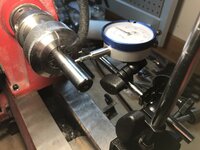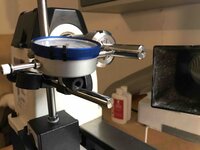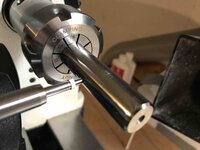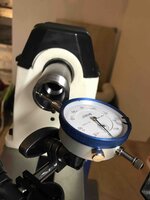PenHog
Member
Hi All,
I'm asking for help. When I put a new Beall collett chuck on my lathe (PSI starter lathe), I can see wobble. I have done the following:
(1) Checked that my eyes are not deceiving me. I placed a thin parting tool at the base of collett chuck, there is no noticeable bouncing, it's smooth. Placing the same tool near the end of the collett chuck produces noticeable up and down movement.
(2) Measured runout at the point closest to the lathe's headstock (on the base of the collett chuck), it is 0.0025 inches.
(3) Measured runout at the point farthest from the lathe's headstock (at the end of the collett chuck, before its grooves), it is 0.005 inches.
(4) Cleaned the 1"x8 tpi threads on the headstock.
(5) Used a leveler to check that the lathe is level across and in depth.
(6) Taken out the screws of the headstock to check they are not bent, and they look fine, and tightened them down. Repositioned the headstock ever so slightly to try to cutdown on the wobble, with no improvement.
(7) Repeated with the older PSI collett chuck I have and found essentially the same runout (it's a little larger), and the wobble persists.
I don't know what to do now. This is the first time I've taken a close look at this issue, since I used to turn in a jaw instead of a collett chuck. But I noticed that there was a noticeable (to me) deviation from true when attaching the cap to the body of a recent pen.
I suspect this has been a problem all along, and I'm only noticing it now since I'm turning thinner pens, and perhaps my standards are getting higher.
Any ideas on what I could try to do to fix this wobble? I would prefer to avoid purchasing a new lathe, but I'll do so if there's no other good option.
Thanks in advance.
I'm asking for help. When I put a new Beall collett chuck on my lathe (PSI starter lathe), I can see wobble. I have done the following:
(1) Checked that my eyes are not deceiving me. I placed a thin parting tool at the base of collett chuck, there is no noticeable bouncing, it's smooth. Placing the same tool near the end of the collett chuck produces noticeable up and down movement.
(2) Measured runout at the point closest to the lathe's headstock (on the base of the collett chuck), it is 0.0025 inches.
(3) Measured runout at the point farthest from the lathe's headstock (at the end of the collett chuck, before its grooves), it is 0.005 inches.
(4) Cleaned the 1"x8 tpi threads on the headstock.
(5) Used a leveler to check that the lathe is level across and in depth.
(6) Taken out the screws of the headstock to check they are not bent, and they look fine, and tightened them down. Repositioned the headstock ever so slightly to try to cutdown on the wobble, with no improvement.
(7) Repeated with the older PSI collett chuck I have and found essentially the same runout (it's a little larger), and the wobble persists.
I don't know what to do now. This is the first time I've taken a close look at this issue, since I used to turn in a jaw instead of a collett chuck. But I noticed that there was a noticeable (to me) deviation from true when attaching the cap to the body of a recent pen.
I suspect this has been a problem all along, and I'm only noticing it now since I'm turning thinner pens, and perhaps my standards are getting higher.
Any ideas on what I could try to do to fix this wobble? I would prefer to avoid purchasing a new lathe, but I'll do so if there's no other good option.
Thanks in advance.




